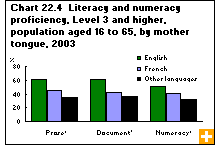Common menu bar links
Mother tongue, literacy and numeracy
Archived Content
Information identified as archived is provided for reference, research or recordkeeping purposes. It is not subject to the Government of Canada Web Standards and has not been altered or updated since it was archived. Please contact us to request a format other than those available.
Results of the 2003 International Adult Literacy and Skills Survey indicated major differences in literacy and numeracy levels among anglophone, francophone and allophone Canadians.
Fewer differences were found among the younger people in the survey and differences almost disappeared when education levels were taken into account. So level of schooling—not language—is strongly linked to the literacy skills required to process written information, be it words or numbers.
In the survey, people whose mother tongue was English scored higher than the other two linguistic groups in various literacy and numeracy tests. Almost 21% of anglophones obtained the highest level of competency in reading comprehension of narrative texts such as editorials, news articles or brochures. By contrast, 13% of francophones and 10% of allophones scored at the highest level. Scores were similar in reading documents such as job applications, pay stubs, transport schedules, road maps, tables and charts.
According to the survey, 42% of the adult population aged 16 to 65 did not obtain at least a Level 3 in reading comprehension, which is seen as the minimum competency for responding to the demands of today’s information-based society.
Literacy varies by province. For example, in New Brunswick, 66% of francophones did not achieve the minimum competency level for narrative texts, compared with 55% of francophones who did not in Quebec, Ontario and Manitoba. New Brunswick also had the highest proportion of anglophones who did not achieve the minimum levels.



